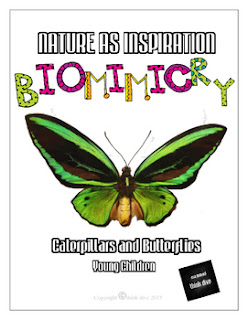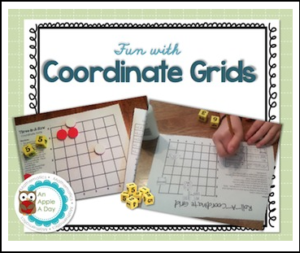Be a Butterfly Detective & Biomimicry for Young Children – Caterpillars and Butterflies
By Sparking Children’s Thinkibility
Grades: Kindergarten – 4th Grade Biology, General Science, Visual Arts
Metamorphosis – one of the greatest mysteries captures children’s attention. How can a caterpillar transform and become a butterfly?
Use cards to help enhance students’ understanding of the life cycle. There are also some activities where observations from eggs, caterpillars, chrysalis, and butterflies are used as inspiration to get new ideas.
Hopefully, these activities will make the learning fun and engaging.
 Link to Be a Butterfly Detective – Life Cycle and Inspiration for Ideas
Link to Be a Butterfly Detective – Life Cycle and Inspiration for Ideas
This booklet contains:
1. Cards
2. Can you identify the different stages?
3. What is the connection between a caterpillar and a butterfly?
4. What do caterpillars and butterflies eat?
5. Fun Facts
6. Metamorphosis Poem
7. Butterfly words – make your own dictionary
8. Ask the caterpillar Sparkling Questions about chrysalis and butterflies
9. Caterpillars are. . .
10. Butterflies are. . .
11. Life cycle
12. Which animal do you like the best? Positive, Negative and Interesting
13. Story writing
14. Symmetrical Butterfly
15. ”Eggcited” about butterfly eggs!
16. Think diving for a butterfly detective – eggs
17. Think diving for a butterfly detective – caterpillar
18. Think diving for a butterfly detective – chrysalis
19 Think diving for a butterfly detective – butterfly
20. Reflection – assessments
For more ideas to study caterpillars and butterflies look at the booklet about Biomimicry. In this booklet the aim is to use the observations of caterpillar, moths and butterflies to design and invent things.
Students can design a robot inspired by moths. Moths fly in the dark and their use their hairy antennea to help them find the way. They also have special eyes, anti-reflective, that helps them to fly in the dark.
Biomimicry an exciting approach to study animals and plants!

The package contains:
1. Why Teach Biomimicry
2. Getting Started Guide
3.How to Observe and Collect Information about Caterpillars
4. Describe a Caterpillar
5. Make a list of things that caterpillars can do.
6. Things I Love about Caterpillars
7. Caterpillar shape poem
8. Make a drawing or model of an interesting body part
9. Use “random” words to invent and design things
10. Imagination design challenge
11. Design challenge
12. Word Caterpillar
13.Design word challenge
14. Fake eyes
15. What if you could measure a crooked line?
16. Design task – saddleback caterpillar
17. Observe and collect Information about Butterflies
18. Describe a butterfly
19. Make a list of things that butterflies can do.
20. I am in awe of butterflies
21. Draw butterfly wings
22. Use “random” word as inspiration
23. Imagination design challenge
24. Design challenge
25.Word butterfly
26. Design word challenge
27. Make an ID card or ID badge
28. Months – Design a robot that can fly in the dark or a solar panel that can capture as much light as possible
29. Observation cards
30. How to use biomimicry in the classroom – inspiration and ideas
31. Links to videos and information
32. Two posters
Link to STEM – Biomimicry for Young Children – Caterpillars and Butterflies
I would be delighted if you like to follow me on:
Follow the Sparking Children’s Thinkibility Facebook Page






